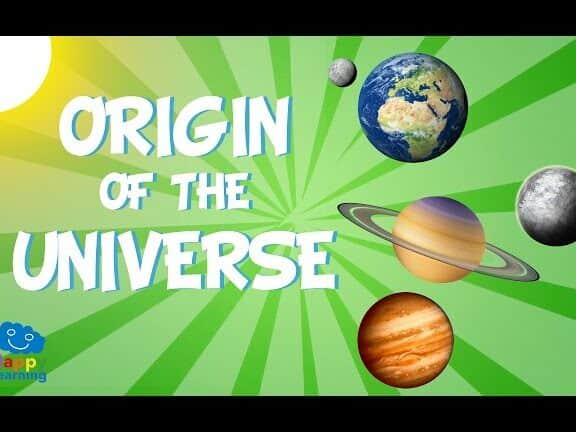Space is a vast and fascinating place! Not every grown-up fully comprehends the enormity of this idea, let alone children. Let’s attempt to explain space to children in a clear and captivating way. If we succeed, there is a chance that the child will not only be temporarily interested in astronomy, but will develop a genuine love for it and possibly make significant scientific discoveries in the future. When discussing the cosmos with your child, imagine how they will remember your story with a smile when they grow up. So, what should you tell your child about space and, most importantly, how should you do it?
Get the Download Link:
Preview the Content:
The vastness of the universe is so immense that its boundaries remain unknown. It came into existence approximately 13.7 billion years ago during the occurrence of the Big Bang. During this momentous event, everything that we know today materialized: the fundamental matter that comprises stars and planets, the forces that govern the interactions between particles, and even the concept of time and space were all born from the explosive process of the Big Bang. The reason behind why this phenomena occurred remains a mystery to humanity.
As time progressed, the universe expanded in all directions and gradually took shape. From energetic swirls, minuscule particles were formed. Hundreds of thousands of years later, these particles combined and transformed into atoms, which are the fundamental building blocks of all visible matter. Simultaneously, light was also born and began to traverse freely through the expanse of space.
As time passed, the Universe started to expand in all directions and eventually started to form. Out of the swirling energy, minuscule particles were created. After hundreds of thousands of years, these particles merged together and formed atoms – the building blocks of everything we observe. It was at this point that light began to travel freely through space.
Imagine if Earth were the size of a cherry tomato, how large would the other planets be? If we were to hold Earth – represented by a cherry tomato – in our hands, the Sun would be positioned 500 meters away from us and have a diameter of just 4.5 meters.
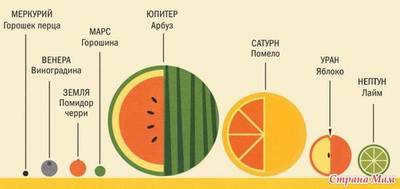
The Milky Way
All the stars visible from Earth are part of large collections – galaxies that resemble enormous cosmic whirlpools. Our galaxy is known as the Milky Way, or simply the Galaxy, and has a shape reminiscent of a fireworks spinner. It contains an immense number of stars, more than a person could possibly count in a lifetime. Our Galaxy rotates continually, albeit at a very slow pace: it takes 225 million years to complete a single revolution. The Milky Way is observable with the naked eye. To witness it, one must venture into the great outdoors, far from the glare of city lights, and gaze up at the heavens. There, a milky white streak of light will come into view – that is the Milky Way.
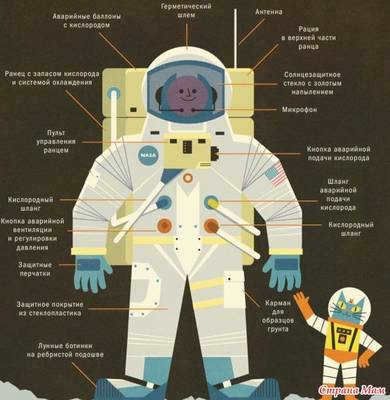
On July 21, 1969, astronauts Neil Armstrong and Buzz Aldrin became the pioneers of lunar exploration by being the first humans to set foot on the Moon. To protect themselves from the extreme conditions of space, they donned specially designed spacesuits. These suits featured multiple layers of insulation to shield the astronauts from the cold and cosmic radiation. Additionally, they were equipped with air tanks that allowed Armstrong and Aldrin to breathe in the vacuum of space. The spacesuits were individually tailored and could be worn for an impressive duration of up to 115 hours. While these suits are quite heavy on Earth, they become almost weightless on the Moon.
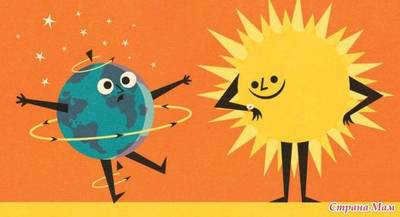
Every day we witness the Sun’s apparent movement across the sky, but this is merely an optical illusion. In reality, the Sun remains stationary while the Earth orbits around it and rotates on its own axis. Over the course of a day, the Earth completes a full revolution on its axis, causing different parts of the Sun to be visible to us. This creates the illusion of the Sun rising and setting, similar to how we perceive a bright lamp when we spin around it.
Regarding: advancements in methodology, presentations, and records
An educational session with older children on the subject: “The Origins of Paper”
Every teacher is aware that paper is the most prevalent and easily obtainable material for engaging with children. However, as adults, we don’t always fully utilize its potential! And yet, any task involving paper is far from mundane.

“He grasped a pencil”
I held a pencil in my hands while providing guidance to parents. Suggestions for parents Engaging in fine arts activities is paramount, not just a mere hundred.

How did I come into existence?
For parents, educators, and anyone looking for information, here is a way to tactfully and easily explain to a child how they came into existence.
How did I come into existence?
One day, your curious daughter or intelligent son will surely ask this difficult question. It’s only difficult for us, adults. For children, asking “Where do children come from?” is completely natural.
Distance support for parents: “Inform your kids about the war! Short-term distance project “Let’s educate children about the war”
Distance support for parents: “Inform your kids about the war! Topic: “We are the legitimate holders of the Glorious Victory” for older and preparatory group children. Objectives: 1. To instill a sense of history.

"TELL US, TELL US" provides insights from discussions with children in the middle and senior preschool years.
This guide offers discussions with children in the middle and senior preschool years on the following subjects: Middle preschool years: "Kibitka" "Piala" "Chest&raq.

Project “Let’s Educate Children about the War, Let’s Teach Children about the Victory”.
During the transition between different social systems, the intergenerational continuity in educating children is disrupted, especially in transmitting moral experiences and core life values. Our preschoolers are not exempt from this.
– To foster the ability to collaborate in a small group setting and cultivate an interest in research activities.
– To stimulate cognitive activity, foster a desire for knowledge acquisition, promote quick thinking, and broaden perspectives.
Required materials: multimedia projector, tennis ball, flashlight, ping-pong ball, printed quiz.
Key focus areas: ICT, health promotion, gamification.
Lesson Course
Throughout history, humanity has always been intrigued by the enigmas of the cosmos. Today, we embark on an enthralling expedition into the vast depths of outer space. Our aim is to unravel the mysteries surrounding the birth of the universe, understand Earth’s position within it, and explore its intricate organization. Additionally, we will acquaint ourselves with the Sun and its orbiting nine planets, paying visits to our neighboring celestial bodies within the solar system, and even venturing beyond.
Slide 2. Stellar systems known as galaxies captivate us with their immense scale, as countless stars are held together by the force of gravity. Some galaxies boast trillions of stars within their expansive domains.
Slide 3. Our galaxy is home to 200 billion stars, and the solar system we reside in is just a minuscule particle. The sun, although seemingly ordinary, is an enormous mass of hot gases, primarily hydrogen and helium. It has a diameter of 1,392,000 kilometers and a surface temperature of 5,500 degrees Celsius. At its core, the temperature soars to a staggering 15,500,000 degrees Celsius. The sun will continue to emit light for approximately 7 billion years until all the hydrogen is transformed into helium.
Slide 4. The sun is encircled by nine planets – Mercury, Venus, Earth, Mars, Jupiter, Saturn, Uranus, Neptune, and Pluto – along with numerous asteroids and comets. The gravitational force exerted by the sun keeps all these celestial bodies in their respective orbits. All planets move in the same direction and within a similar plane. Their orbits can be described as elongated circles, or ellipses.
The duration during which a planet completes a revolution around the sun is known as its year. Furthermore, a single rotation around its axis is referred to as a sidereal day.
Slide 5. Our solar system is immensely vast according to our standards, but it represents the closest vicinity to Earth. Beyond it extends the vast expanse of outer space, teeming with stars and other planetary systems. Over twenty of these systems have been identified so far.
Slide 6. Distances between objects in the vastness of deep space are significantly greater compared to those within the solar system. Therefore, the unit of measurement utilized is the light year, which denotes the distance traveled by light within a year. This distance is approximately 10 billion kilometers. For instance: the nearest star, Alpha Centauri, is situated 4.3 light years away. If a spaceship were to travel at a speed of 8km/sec, the journey would endure for 162,000 years.
Slide 7. Earth’s only natural satellite is the Moon. It originated from debris that was ejected into space when another celestial body collided with our planet. The Moon’s surface is marked by numerous craters caused by meteorite impacts. Its gravity is six times weaker than that of Earth, which is insufficient to retain an atmosphere, resulting in a perpetually black sky on the Moon, even during the day. The sunlit regions can reach temperatures as high as 117 degrees Celsius, while the shaded areas can cool down to 153 degrees Celsius.
Slide 8. The Moon is our neighboring celestial object, and humans have had the opportunity to explore it. The Moon’s surface is adorned with craters. It completes an orbit around the Earth in approximately one month, always presenting the same face towards us. Both Russian and American astronauts have successfully landed on the Moon, experiencing periods of daylight and darkness lasting around two weeks each.
Slide 9. Eclipses occur when the Moon, Earth, and Sun align in a straight line.
Experiment: A mini eclipse can be demonstrated using a tennis ball to represent the Earth, a ping-pong ball to represent the Moon, and a flashlight to represent the Sun.
– Why can’t a solar eclipse be seen everywhere on Earth?
Slides 10-11: In ancient times, people believed that the Earth was supported by three whales or three elephants.
Move to the right – place your left foot – jump (lightly, in place).
Move to the left – place your right foot – nod.
Step forward – place your left foot – clap.
Step back – place your right foot – sit down.
This sequence is repeated 4-5 times, gradually increasing the speed of the movements.
The children are divided into two groups and asked questions about the topic.
Summarizing the quiz results: Each correct answer earns the team a star.
“In today’s lesson, I learned…”;
“After the lesson, I felt like…”;
Based on the quiz results, it is evident that you have successfully completed the tasks in our lesson.
1. Basov V., Klimenko O., Atlas of the Universe for Children. Institute for Space Research. 2001.
1. What is the name of our galaxy? (Milky Way)
3. What defines a galaxy? (A star system held together by gravity).
4. What is the sun? (A star)
5. What elements make up the Sun? (Hydrogen and helium)
6. How many planets orbit the Sun? (Nine)
7. List these planets. (Mercury, Venus, Earth, Mars, Jupiter, Saturn, Uranus, Neptune, Pluto).
8. What is the time it takes for a planet to complete one orbit around the Sun? (Year)
9. And the time it takes for a planet to complete one rotation on its axis? (A day)
10. What is the moon? (Earth’s satellite)
11. What is the duration of the Moon’s orbit around the Earth? (Approximately one month)
12. When does a solar eclipse occur? (When the Earth, Moon, and Sun align.)
13. How did our ancestors envision the shape of the Earth? (As flat, supported by three whales, elephants, or a turtle).
14. Which star is the closest to Earth? (Alpha Centauri)
Children are fascinated by the stars, moon, planets, and space. Exploring the world around us is incredibly thrilling! Fortunately, a vast amount of knowledge has already been gathered about these captivating subjects. The only task left is to organize and present this information in an engaging and comprehensible manner for children.
When and how should you introduce a child to the concept of space?
Typically, children start asking questions about space before they even start school, around the ages of 4-5. However, it’s important not to overwhelm them with complex terminology right away. Instead, it’s best to start by explaining the basics and building their understanding from there. If they grasp the main concepts and show interest, they can gradually explore more as they grow older.
One area of space that has been extensively studied is known as near-Earth space. This is where space exploration first began, and it’s where the first space rockets ventured.
Now, let’s delve into the theory.
What is the composition of the solar system?
The solar system is comprised of various celestial bodies that orbit around the Sun, including planets, their moons, asteroids, comets, meteorites, and space dust. According to scientists, it is believed that the solar system originated from the explosion of one or more stars approximately 4.6 billion years ago.
Within the solar system, there are a total of 8 planets, which can be categorized into two types: terrestrial planets and giant planets. The terrestrial planets, consisting of Earth, Mercury, Venus, and Mars, are relatively small and primarily composed of metallic iron (core) and silicates (mantle). On the other hand, the giant planets – Jupiter, Saturn, Uranus, and Neptune – are predominantly composed of helium and hydrogen gas.
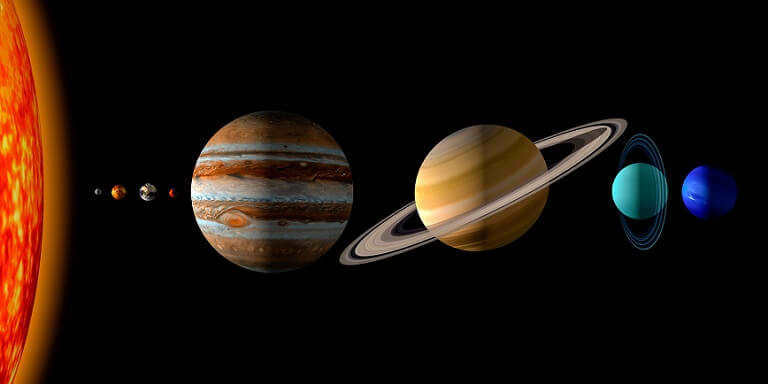
The key distinction between the Earth and the other celestial bodies lies in its possession of water, the fundamental element for life. Another distinguishing factor is the composition of the Earth’s atmosphere, the enveloping gaseous layer. Comprised of various gases, the Earth’s atmosphere notably contains oxygen, which sustains our respiration.
The celestial bodies proximate to the Earth include Mercury, Venus, Mars, Jupiter, and Saturn.
The Sun, which is the center of our solar system, is just one of many stars in the universe. It is not larger or brighter than the other stars, but what sets it apart is its proximity to Earth. While the distance between the Sun and Earth is over 149 million kilometers, it is actually relatively small in comparison to the vast distances between other stars and our planet. This close distance is what makes the Sun appear blindingly bright and capable of emitting heat that can burn our skin.
In contrast to planets, which are cooler and can only be seen through the reflected light of nearby stars, stars themselves are bright, hot, and emit their own light. The Sun, being a star, fits this description.
The Sun’s radiation is crucial to sustaining life on Earth as it serves as our main source of energy. It plays a significant role in determining the climate of our planet. Additionally, sunlight is essential for photosynthesis, the process by which green plants produce organic matter and enrich the Earth’s atmosphere with oxygen.
The Sun, similar to all other stars, is primarily composed of hydrogen and helium. Its mass constitutes over 99% of the total mass of the Solar System. It is worth noting that the mass of the Sun surpasses that of the Earth by a staggering 300,000 times.
Aside from the Sun and planets, the Solar System also encompasses other captivating and luminous entities, such as comets. Comprised mainly of dust and ice, these objects add to the system’s allure.
Meteorites are stones that have descended to Earth from outer space. They vary from asteroids primarily in their size: meteorites are much smaller in comparison. Moreover, they are discovered across the entire solar system, unlike asteroids that tend to be concentrated in specific locations. The majority of meteorites consist of fragments from asteroids. These extraterrestrial objects can be identified both visually and with the assistance of metal detectors. Meteorites serve as a valuable source of information for scientists, providing insights into processes and phenomena occurring on other planets. The largest meteorite ever discovered, weighing over 60 tons, was found in Africa.
What are the Universe and galaxies?
A galaxy is a collection of stars, along with dust and gas clouds and nebulae. Galaxies formed shortly after the appearance of stars, approximately 150 million years after the Big Bang.
The number of galaxies is immeasurable. Some are small with only a few million stars, while others are massive with hundreds of billions of stars. Stars within galaxies are held together by the force of gravity, constantly moving, being born and dying (exploding). Scientists believe that stars, galaxies, and planets are gradually moving away from each other, causing the universe to expand.
Earth resides in a galaxy known as the Milky Way, which can be seen in the night sky as a luminous, cloudy band.
Stars and constellations
We have previously discussed stars, with the Sun being one of them. Now, let’s delve deeper into what stars are and their characteristics.
In reality, a star is an enormous gas ball that emits light due to the release of an immense amount of energy. This energy is a result of constant nuclear reactions occurring within each star. Nebulae, which are clouds of space dust, float in space. As the gas in these clouds heats up, it reaches a specific temperature where hydrogen nuclei start fusing into helium nuclei, giving birth to a star.
The exact quantity of stars in the universe remains unknown. There are likely over 100 billion galaxies alone, each containing clusters of stars. It is believed that on a clear night, one can observe over 3,000 stars in the sky with the naked eye.
Stars generate their own energy, causing them to heat up and emit light. The brightness of a star is determined by the amount of energy it produces and its distance from Earth. Initially, all stars appear silver when observed from Earth. However, in reality, they can exhibit a wide range of colors based on their size and temperature. Hotter stars emit blue or white light, while cooler stars emit red or orange light.
Scientists believe that the largest star is 150-250 times more massive than the Sun, while the smallest star is 75 times larger than Jupiter. The lifespan of a star decreases as it increases in size. Nevertheless, even in the most unfavorable scenarios, a star’s life cycle spans millions of years.
The nearest star to Earth, aside from the Sun, is Proxima Centauri, located approximately 40 trillion kilometers away. It takes 4.2 years for its light to reach our planet. Even with the fastest spaceship available, it would take 75,000 years to reach Proxima Centauri. This gives us an idea of just how vast the distances to other stars are.
Clusters of stars are known as constellations. In ancient times, people named constellations after gods, heroes, and animals. Among the most well-known constellations are the Big Dipper and the Little Dipper.
The Big Dipper is a well-known constellation that consists of seven stars arranged in the shape of a bucket with a handle. It is easily visible and can be seen throughout the year. The best time to observe the Big Dipper is during the autumn and winter seasons. According to ancient Greek mythology, the god Zeus fell in love with a beautiful nymph named Callisto. However, Zeus’ wife, Hera, became jealous and transformed Callisto into a bear. One day, Callisto’s son, Arkas, encountered the bear and was about to shoot it, not realizing that it was his own mother. Fortunately, Zeus intervened and saved Callisto by hurling her into the sky.
Other notable constellations include the Swan, Lion, Dove, Hare, and others, which resemble the shapes of these animals.
Living on the Moon would certainly not be a comfortable experience, to say the least. The lack of atmosphere results in drastic temperature fluctuations, ranging from -173 to +170 degrees Celsius. Additionally, the lunar sky is perpetually dark and adorned with a multitude of stars.
In terms of composition, the Moon and Earth bear many similarities. In fact, there is a theory suggesting that the Moon was formed from fragments of Earth as a result of a collision. Iron constitutes a significant portion of the Moon’s composition, and it orbits around the Earth.
- During the New Moon phase, the Moon is not visible.
- As the Moon progresses, it transforms into a noticeable narrow sickle in the sky, known as the young Moon.
- The first quarter of the waxing Moon is characterized by half of the Moon being illuminated.
- Finally, the full moon phase occurs when the entire Moon is illuminated.
For centuries, humanity has been adapting to the cycles of the Moon – even our conventional calendar aligns roughly with the number of days it takes for the Moon to complete its phases.
An exceptionally uncommon occurrence is known as a blue moon – the second full moon in a single month. This phenomenon can be attributed to the slightly faster pace at which the Moon transitions through its phases, surpassing the typical 12 times a year.
What does gravity mean?
Gravity, also known as gravitation, refers to the attractive force between two objects. The law of universal gravitation applies to the entire universe and all the planets within our solar system. This means that the Moon is influenced by the gravitational force exerted by the Earth, while the Earth is pulled towards the Sun by the same force.
Gravity is responsible for keeping us grounded on Earth and giving us a sense of weight. Weight, in fact, is the force experienced by an object due to gravity. Although the mass of an object remains constant, the force of gravity can vary. For example, the Moon, being much smaller than the Earth, has a weaker gravitational pull. As a result, a person who weighs 65 kilograms on Earth would only weigh 11 kilograms on the Moon.
Discover fascinating aspects of physical phenomena, laws of motion, and interactions, and much more in an engaging game format – through online physics courses designed for children aged 7-14 years old, offered by Umnasia.
As per the principles of physics, in order to overcome the Earth’s gravity, one must locate a forceful entity that can propel the body to reach the initial cosmic velocity of 28,000 kilometers per hour. Naturally, achieving such speed is only possible through a rocket.
Black holes possess an immensely powerful gravitational force, which can cause objects to vanish once they enter the event horizon.
What are black holes?
Black holes are a cosmic phenomenon that has been the subject of many fantastic movies and books due to its mysterious nature. They are believed to be stars that have collapsed under their own gravity, resulting in a mass greater than that of the Sun. The reason black holes appear black is because they do not reflect any light, making them extremely difficult to study. However, scientists have discovered that it is still possible to detect black holes by observing the movement of objects around them, as their orbits are affected by the gravitational pull of the black hole.
There are also supermassive black holes, which are formed through the merging of multiple black holes or the attraction of stars to black holes. In fact, there is a supermassive black hole located at the center of the Milky Way.
What is the role of astronauts?
Individuals who work on a space station and venture into outer space, are responsible for testing space equipment and conducting scientific research in this field are referred to as astronauts. Scientists who study celestial bodies are also considered astronauts.
Let’s delve deeper into the responsibilities of astronauts. The first person to venture into space, as previously mentioned, was Yuri Gagarin. His heroic feat was commemorated not only through the naming of cities and streets, but also a small planet and a crater on the Moon.
Valentina Tereshkova, the first female astronaut, embarked on her space journey in 1963 and completed 48 orbits around the Earth. She spent approximately three days in space, during which she conducted studies on the Earth’s atmosphere and captured numerous photographs.
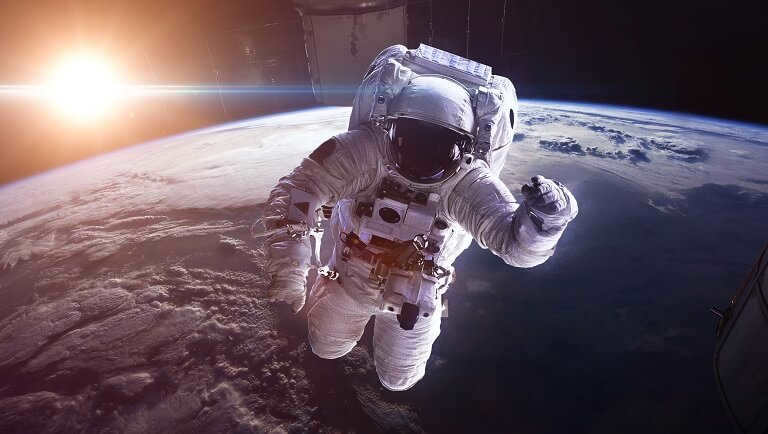
In the modern era, an individual with dreams of becoming an astronaut can pursue various professions, such as a scientist, engineer, or another occupation, but only after undergoing rigorous training. It is essential for an astronaut to maintain excellent health and endure immense physical strain. Moreover, even after passing strict physical assessments, it can take more than two years before one finally embarks on a journey to space. This period is dedicated to theoretical training, examinations, and direct preparations within a group for the upcoming mission.
Contrary to popular belief, the majority of an astronaut’s time is not spent in space, but rather within laboratories.
It is widely known that animals were also astronauts before humans. In 1960, Belka and Strelka, the dogs who successfully completed a flight, orbited the Earth 17 times in just 25 hours. These dogs were selected from a diverse range of breeds, including pedigree dogs. Surprisingly, it was the two dogs of unknown breed that proved to be the most adaptable for the mission. Following the successful flight, both dogs returned in good health and were subsequently placed in the Institute of Aviation Medicine.
Another creature to venture into space was a rat named Hector, sent on a French rocket. Hector spent a total of 40 minutes in space and safely returned to Earth. Additionally, turtles have also been sent into space, and remarkably, everything went smoothly.
However, not all flights ended favorably for animals. For instance, in 1962, the rat Castor unfortunately perished due to technical issues resulting in overheating. Similarly, three days later, the rat named Pollux suffered the same fate. During the flight, the head section of the rocket detached from the main body, where the animal was housed, and despite extensive search efforts, it was never recovered.
In contrast, the French cat Felicette, carefully chosen from a pool of 30 stray cats in Paris, had a successful flight experience. She endured weightlessness for approximately 5 minutes and was recovered along with the capsule after just 30 minutes. However, another cat’s luck ran out a few days later. It took two days to locate the capsule containing the unfortunate feline, and sadly, the animal was found deceased.
The exploration of the universe continues to this day. Experts are primarily focused on understanding which planets have had and currently have the potential to sustain life, and which of them could potentially be inhabited by humans in the future.
Just recently, an American rover equipped with a drone helicopter successfully touched down on Mars. This rover will collect and analyze soil samples from the planet, determining its habitability for humans and searching for any signs of past life on Mars. Scientists currently believe that there may have been life on Mars billions of years ago, when water still existed on its surface.
In the past, nearly half of the space missions to Mars ended in failure due to the challenges posed by the planet’s atmosphere during landing. However, this recent mission was a success, with the rover transmitting its first black-and-white image of Mars just three minutes after landing.
Incidentally, the Russian engines powered the launch vehicle carrying the American rover.
A handful of intriguing space facts
Now that you’ve acquired a wealth of useful information, let’s throw in some fascinating facts.
- Mars experiences a mesmerizing blue-hued sunset.
- Jupiter, Saturn, Neptune, and Uranus lack a solid surface entirely.
- Saturn’s rapid rotation causes it to flatten itself.
- Uranus holds the title for the coldest planet in our solar system.
- The universe is estimated to be approximately 14 billion years old.
- Out of all the planets in our solar system, Earth is the sole one not named after a deity.
- Venus takes the crown as the brightest planet in our solar system, reflecting 76% of the Sun’s light.
- Now that we have gained extensive knowledge about the cosmos, there are still countless discoveries awaiting scientists. The exploration in this field requires substantial funding and immense effort. Furthermore, our own planet, Earth, remains largely unexplored. For instance, only a small fraction of our world’s oceans have been thoroughly investigated.
What can be shared with a curious child regarding the wonders of space?
There are numerous options available: an abundance of movies, cartoons, books, and educational videos on the internet that delve into the fascinating realm of space.

Children might enjoy watching movies about space.
There are plenty of space-themed books available for kids.
Space exploration games can be a fun way for children to learn about the universe.
Observing stars can be an enjoyable and free activity. Some bright stars, such as Sirius, Vega, Betelgeuse, Venus, Mars, Saturn, the Moon, and Jupiter, can be seen without any equipment. However, for a more detailed observation, special equipment like a telescope or astronomical binoculars and a tripod may be needed. It is best to find a clear sky and an open space away from city lights, such as a field, forest, or meadow.
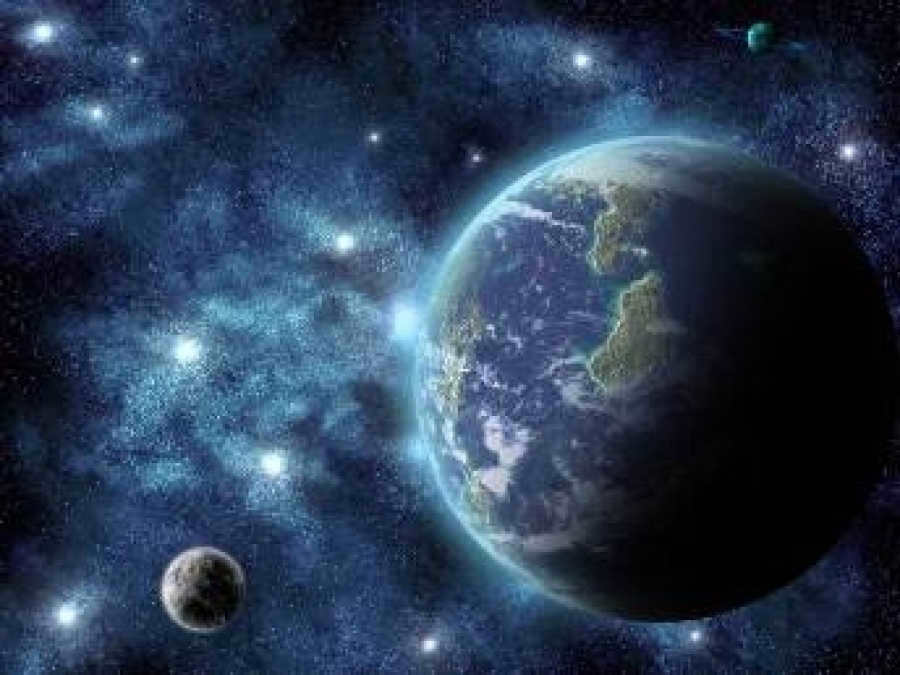
The Universe is an immense expanse filled with planets, stars, galaxies, black holes, nebulae, and more. Our planet is merely a tiny speck in the boundless vastness of the cosmos.
Galaxies are formed by clusters of stars with accompanying planets. These galaxies come in various sizes and shapes, and their count is infinite.
In addition, contemporary scientists propose the theory of the expanding universe. This suggests that galaxies, planets, and stars are gradually moving away from each other, causing the boundaries of the universe to expand. The intriguing aspect is that the universe has no definitive boundaries, leaving us forever unaware of its origins and limits.
The galaxy that encompasses our planet is known as the Milky Way. Within its expanse reside an enormous multitude of stars. During the night, we can observe the Milky Way as a luminous, ethereal streak across the sky.
Stars within galaxies are in constant motion and undergo both birth and death, with new stars being born as others explode.
The sun, as a star, also follows this pattern. Its lifespan is estimated to be around 10-15 billion years.
Every object in the universe adheres to specific laws and exists within a precise order. However, scientists have yet to fully comprehend all of these laws, as many aspects of the cosmos remain enigmatic to humanity.
Here is an intriguing collection of space facts for children.
The universe is so vast that its boundaries are still unknown. Its existence began approximately 13.7 billion years ago with the occurrence of the Big Bang. This event gave rise to everything we know today: the matter composing stars and planets, the fundamental forces governing particle interactions, and even the concepts of time and space. The reason behind the Big Bang remains unexplained by humans.
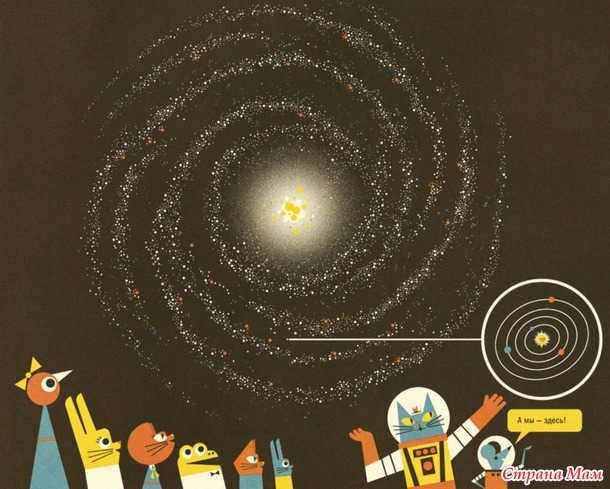
In our solar system, there are eight planets that orbit the Sun in the same direction. The Sun’s gravitational force keeps the planets together, acting like an invisible rope to prevent them from breaking free and drifting off into space. The first four planets, which are closer to the Sun, are rocky and known as the terrestrial planets. These planets have a solid surface that you can walk on. The remaining four planets are composed mostly of gases. If you were to stand on their surface, you would fall through and travel all the way through the planet. These gas giants are much larger than the terrestrial planets and are located far apart from each other.
Imagine if the Earth were a cherry tomato, how would the size of the other planets compare? If we were to hold the Earth, which is represented by this cherry tomato, in our hands, the Sun would be 500 meters away from us and have a diameter of only 4.5 meters.
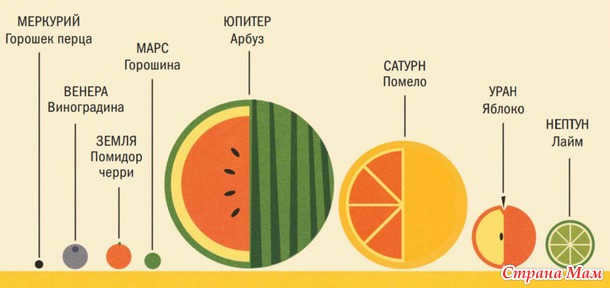
All the stars visible from Earth belong to vast clusters of galaxies resembling enormous celestial whirlpools. Our galaxy, known as the Milky Way or simply the Galaxy, takes on the shape of a firecracker pinwheel. It contains an astronomical number of stars, more than a person could ever hope to count in a single lifetime. The Milky Way rotates constantly, albeit at a leisurely pace, requiring 225 million years to complete a full revolution. This awe-inspiring sight can be observed by the naked eye. To behold this breathtaking spectacle, one must venture into the serene beauty of nature, far from the disruptive glow of city lights, and gaze up at the heavens. There, a luminous streak of milky white light shall unveil itself—a wondrous manifestation of our beloved Milky Way.
July 21, 1969 marked a historic moment as Neil Armstrong and Buzz Aldrin became the pioneering individuals to set foot on the lunar surface. Equipped with specially designed spacesuits, they were shielded from the harsh cold and cosmic radiation by the multi-layered coating of their suits. Additionally, the astronauts carried air tanks that facilitated their breathing in the vacuum of space. These spacesuits were customized for each astronaut and allowed them to comfortably walk for hours on end, with a maximum duration of 115 hours. It is worth noting that the reduced gravity on the Moon made it significantly easier for them to maneuver in these spacesuits, a feat that would be much more challenging on Earth.
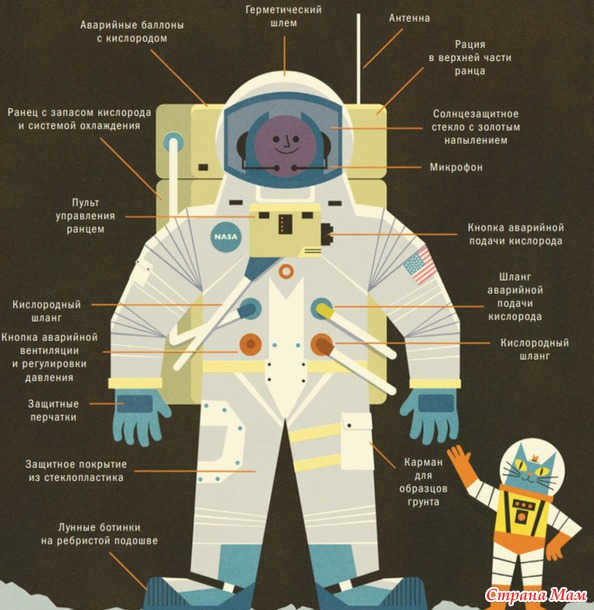
Every day we witness the Sun’s apparent movement across the sky, but it is actually an optical illusion. In reality, the Sun remains stationary while the Earth orbits around it and rotates on its own axis. Within a 24-hour period, the Earth completes a full rotation on its axis, causing the Sun to appear from different angles. This is why we perceive the Sun as rising and setting. It’s similar to twirling around a bright lamp: it gives the illusion of appearing and disappearing.

The stars, moon, planets, and cosmos are all fascinating to children. Discovering and understanding the world around them is an exciting adventure! Fortunately, we have already gathered a wealth of knowledge about these intriguing subjects. The challenge now is to present this information in a structured and engaging way that captures a child’s attention and keeps them entertained.
Children usually begin asking questions about this subject even before they start school, around the age of 4-5. Instead of overwhelming the child with complex terms, it is better to first explain the essence. If they grasp the main idea and become interested, they will gradually learn the rest as they grow older.
The initial concept to convey is what exactly lies beneath the beautiful and mysterious word “space”. In present times, space is defined as the vast expanse surrounding our planet – an infinite realm where stars move, planets revolve, and comets soar. It is as if space is in contrast to the Earth.
Centuries ago, the idea of space encompassed not only the areas beyond the Earth but also its surface. In ancient Greece, the term “cosmos” referred to a “ordered universe”. It is no surprise that it translates to “order” and “arrangement” in Greek. The ancient Greeks believed that beauty and order were interconnected concepts.
The near-Earth space is the most extensively researched area of space. It is where the exploration of space originated, and it was there that the initial space rockets ventured into.
The initial individual to have traveled in space, that is, beyond the Earth, was Yuri Gagarin. He embarked on a space journey on April 12, 1961 aboard the vessel “Vostok-1”. The mission lasted for 108 minutes. The pioneering astronaut safely returned, showcasing the feasibility of human space travel. As a result, April 12 is celebrated as the Day of Cosmonautics in Russia.
Now, let’s explore the theory.
What is the composition of the solar system?
The solar system is comprised of various celestial bodies that orbit around the Sun, including planets, their moons, asteroids, comets, meteorites, and space dust. Scientists believe that the solar system originated from the explosion of one or more stars approximately 4.6 billion years ago.
When categorizing the planets in the solar system (a total of 8), scientists classify them into two groups: terrestrial planets and giant planets. Terrestrial planets, which include Earth, Mercury, Venus, and Mars, are relatively small and are primarily composed of metallic iron (in their core) and silicates (in their mantle). On the other hand, giant planets like Jupiter, Saturn, Uranus, and Neptune are predominantly made up of helium and hydrogen gases.

Earth stands out among the other planets due to its possession of water, the essential element for sustaining life. Additionally, Earth is unique in terms of its atmospheric composition, which consists of a gaseous shell enveloping the planet. Within Earth’s atmosphere, a variety of gases can be found, including oxygen, the very substance we rely on for respiration.
In close proximity to Earth lie several neighboring planets, namely Mercury, Venus, Mars, Jupiter, and Saturn.
The star that the planets revolve around, known as the sun, is simply one of many stars in the universe. However, what sets it apart is its proximity to Earth. While the distance may seem vast, with over 149 million kilometers separating us, it is actually relatively small compared to the distances to other stars. This close proximity is what makes the sun appear blindingly bright and capable of warming and burning our skin. Stars, in general, are luminous, hot, and emit their own light, unlike planets which are cooler and only visible due to the reflected light from nearby stars.
The sun’s radiation serves as our primary source of energy. It plays a crucial role in shaping Earth’s climate and sustaining life on our planet. This is because sunlight is essential for photosynthesis, the process by which green plants convert sunlight into organic matter and enrich the Earth’s atmosphere with oxygen.
Similar to every other star, the Sun primarily consists of hydrogen and helium. It accounts for over 99% of the total mass of the solar system. Meanwhile, the Sun’s mass surpasses that of the Earth by a staggering 300,000 times.
Aside from the Sun and the planets, the Solar System also encompasses other captivating and luminous entities known as comets. Comets are predominantly composed of dust and ice.
Observing them is an incredibly rare occurrence, but it is always a sight to remember: a luminous beacon traversing the nighttime sky, adorned with a blazing “tail” composed of minuscule particles of dust. This captivating and enigmatic comet originates from the outermost regions of space, right on the fringes of our solar system. It is within the Kuiper Belt and the Oort Cloud that millions of comets traverse in a chaotic dance. Occasionally, these comets collide, altering their trajectory, allowing some to “discover” the path to the Sun.
The formation of the “tail” in a comet is a result of its approach towards the Sun. The heat and radiation emitted by the Sun give rise to the solar wind, which forcefully blows dust and gas away from the comet. As the comet draws nearer to the Sun, it gradually melts. This process is not swift and can span thousands of years.
Asteroids, which means “star-like” in Greek, are celestial bodies that resemble small planets. These rocky objects lack an atmosphere and revolve around a star. Scientists believe that asteroids are remnants from the early stages of the solar system’s formation. They primarily orbit between Mars and Jupiter, but some can be found beyond the orbit of Neptune.
Meteorites are celestial rocks that descend to the Earth’s surface from the vast expanse of outer space. They are distinguishable from asteroids primarily by their size, as meteorites are significantly smaller in comparison. Furthermore, meteorites can be discovered throughout the entirety of the solar system, in contrast to asteroids which are typically concentrated in specific regions. It is worth noting that the majority of meteorites are remnants of asteroids. These cosmic fragments can be identified both visually and with the assistance of metal detectors. Meteorites serve as invaluable tools for researchers, enabling them to gather extensive insights into processes and phenomena occurring on other planets. The most colossal meteorite discovered to date, weighing over 60 tons, was located in Africa.
The Sikhote-Alin meteorite is the largest fallen meteorite in our country. It got its name from the ridge in the Far East where it landed in 1947. When multiple pieces of the same meteorite are found in one location, it is referred to as a meteor shower, and that’s exactly what happened in this case. The Fersman Mineralogical Museum in Moscow houses the largest specimen from this meteor shower, weighing 1745 kilograms. This museum is renowned for having one of the biggest collections of meteorites in Russia.
What do we mean by the universe and galaxies?
In the realm of philosophy, the universe is defined as the entirety of existence, while the “astronomical” Universe refers to the portion of the world that is observable and subject to scientific exploration. This vast expanse encompasses planets, stars, galaxies, black holes, and more. The distinction between the universe and space in this context is a matter of debate. Some view these terms as interchangeable, while others propose that the cosmos is the origin of everything and the Universe arose from a cosmic explosion. Alternatively, some assert that the cosmos is a subset of the Universe. It is generally agreed upon that the universe is boundless, lacking both a definitive beginning and end.
Galaxies are clusters of stars that also contain dust, gas, and nebulae. Galaxies formed shortly after the formation of stars, which occurred approximately 150 million years after the Big Bang.
The number of galaxies is immeasurable. Some are small and consist of only a few million stars, while others are enormous, with hundreds of billions of stars. Gravity holds the stars within galaxies together, causing them to constantly move, be born, and die (explode). Scientists believe that stars, galaxies, and planets are gradually moving away from each other, resulting in the expansion of the universe.
Our planet, Earth, resides in the Milky Way galaxy. This galaxy is visible as a faint, glowing band in the night sky.
We have previously mentioned celestial bodies, one of which is our very own Sun. Now, let’s delve deeper into the nature of stars and their defining characteristics.
A star, essentially, is a massive sphere of gas that emits light and heat due to its immense energy output. This energy is generated through ongoing nuclear reactions that occur within each individual star. Throughout space, there are swirling clouds of cosmic dust known as nebulae. Within these clouds, the gas heats up and, once it reaches a certain temperature, hydrogen nuclei begin to fuse together, giving birth to a new star.
The precise number of stars in the universe remains unknown. There are likely over 100 billion galaxies alone, each containing vast clusters of stars. It is estimated that on a clear night, the naked eye can discern more than 3,000 stars illuminating the sky.
Stars generate their own energy, causing them to heat up and emit light. The luminosity of a star is determined by the amount of energy it produces and its distance from Earth. Initially, when viewed from Earth, all stars appear silver. However, in reality, they can exhibit a wide range of colors depending on their size and temperature. Hotter stars emit blue or white light, while cooler stars emit red or orange light.
It is hypothesized that the largest star is 150-250 times more massive than the Sun, while the smallest star is 75 times larger than Jupiter. The larger the star, the shorter its lifespan. Nevertheless, even in the most unfavorable scenario, a star’s life cycle can span millions of years.
The nearest star to Earth, apart from the Sun, is Proxima Centauri, located at a distance of just under 40 trillion kilometers. It takes 4.2 years for its light to reach Earth. Even with the fastest spaceship, it would take 75,000 years to reach Proxima Centauri. This gives you an idea of just how vast the distances are between stars.
Clusters of stars are known as constellations. In ancient times, constellations were named after gods, heroes, and animals. Among the most well-known constellations are the Big Dipper and the Little Dipper.
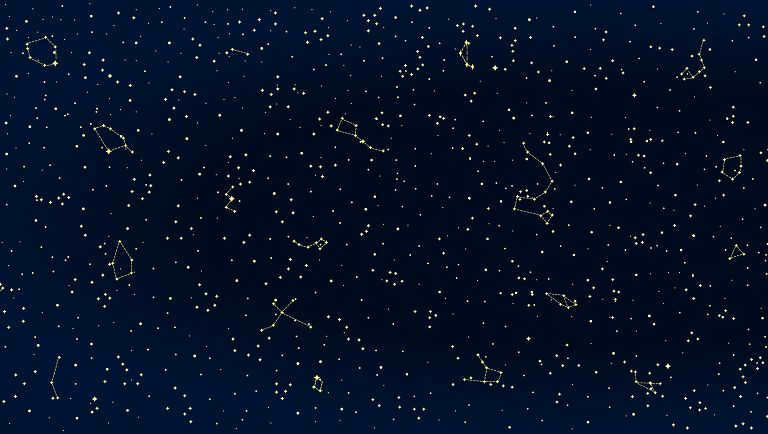
The constellation known as Ursa Major contains a group of 7 stars that form the shape of a dipper with a handle. It is a well-known constellation that can be easily seen at any time of the year. Ursa Major is particularly prominent during the autumn and winter seasons. According to ancient Greek mythology, the god Zeus fell in love with a beautiful nymph named Callisto. However, Zeus’ wife Hera, who was deceived by her husband’s infidelity, became furious and transformed Callisto into a bear. One day, Callisto’s son Arkas encountered the bear and was unaware that it was his own mother. Arkas intended to shoot the bear, but Zeus intervened and saved his beloved by lifting her up into the sky at the very last moment.
The two stars on the outer edges of the Big Dipper’s bucket, when looked at slightly upwards, lead to Polaris, which always points north. This star marks the beginning of the “handle” of the smaller bucket known as the Little Dipper. While not as bright as the Big Dipper, it is still clearly visible. The Little Dipper is located at the North Pole of the world and can be seen year-round in the Northern Hemisphere.
Now, let’s discuss some other constellations:
- Cassiopeia. This constellation is associated with a legend about the wife of the Ethiopian king, Cassiopeia, who was tied to a chair and forced to endlessly circle around the North Pole. At times, she would be upside down. The stars of Cassiopeia form the letter “m”, which appears upside down in the spring and summer.
- Pegasus is a celestial formation of significant size that draws its name from the legendary creature with wings. A prominent feature of this constellation is the Great Square of Pegasus, which can be easily identified in the night sky.
- Andromeda is another constellation that pays homage to a mythical princess situated between Pegasus and Cassiopeia.
Other constellations, such as Swan, Lion, Dove, Hare, and more, bear resemblance to these animals when observed in outline.
The Earth’s Natural Satellite: The Moon
The Moon serves as the Earth’s only natural satellite. It stands as a remarkable extraterrestrial celestial body that humanity has successfully explored. The Soviet interplanetary station Luna-2 achieved this feat in 1959. Neil Armstrong became the first person to step foot on the Moon in 1969. However, no manned missions have taken place since the early 1970s.
Living on the Moon would present various challenges due to its lack of atmosphere, resulting in extreme temperature fluctuations ranging from -173 to +170 degrees Celsius. The lunar sky remains a perpetual black canvas adorned with countless stars.
In terms of composition, the Moon bears striking similarities to the Earth. There is even a theory suggesting that the Moon formed from fragments of the Earth following a cosmic collision. Iron predominantly constitutes the Moon’s composition as it orbits around our planet.
The Moon itself does not emit light – it merely reflects sunlight. The amount of light it reflects depends on its position relative to the Earth and the Sun. As the Moon goes through its phases, the amount of illuminated surface visible from Earth changes:
- During a new moon, the Moon is not visible.
- During a waxing crescent moon, a narrow sickle shape can be seen in the sky.
- During the first quarter moon, half of the Moon is illuminated.
- During a full moon, the entire Moon is illuminated.
During the waning phase of the Moon, which includes the waning Moon phase, the last quarter phase (when half of the Moon is illuminated again), and the old Moon phase, the Moon gradually decreases in illumination. This phase is followed by the new moon phase, in which the Sun and the Moon are aligned on the same side of the Earth, resulting in the side of the Moon facing the Earth being unilluminated by the Sun.
Throughout history, humanity has been attuned to the different phases of the Moon. In fact, our standard calendar is designed to align with the approximate duration of the lunar cycle, with each month consisting of roughly the same number of days as the Moon takes to go through all its phases.
A particularly rare phenomenon is the occurrence of a blue moon, which refers to the second full moon to appear within a single month. This phenomenon is due to the fact that the lunar phases change slightly faster than 12 times a year.
What is gravity?
Gravity, also known as gravitation, is the phenomenon of attraction between two objects. The law of universal gravitation governs the behavior of the entire universe and all the celestial bodies within it. As a result, the Moon is influenced by the gravitational force exerted by the Earth, and in turn, the Earth is drawn towards the Sun by the same force.
The law of universal gravitation was first discovered by the renowned English scientist, Isaac Newton, in the 17th century. Newton’s inspired observations of an apple falling from a tree (legend has it that the apple even landed on his head, capturing his attention) led to this groundbreaking revelation. According to Newton’s laws of motion, an object in motion tends to stay in motion along a straight path unless acted upon by an external force. In the case of planets, their natural inclination is to move away from the Sun, but the gravitational pull of the Sun prevents them from veering off into space, keeping them in their stable orbits.
Gravity is responsible for our connection to the Earth, and as a result, we experience a feeling of weight. Weight can be defined as the force exerted on an object due to gravity. While the mass of an object remains constant, the force of gravity can vary. This is why the Moon, being much smaller than the Earth, has a lesser degree of gravity. For instance, an individual who weighs 65 pounds on Earth would only weigh 11 pounds on the Moon.


Discover a fascinating way to learn about physical phenomena, the laws of motion, and interactions with Umnasia’s online physics courses for children aged 7-14.
According to the principles of physics, overcoming the Earth’s gravitational pull requires finding a force that can accelerate an object to the first cosmic speed of 28,000 kilometers per hour. Only a rocket has the capability to reach such a velocity.
In the realm of black holes, gravity is incredibly strong, causing objects to vanish if they enter.
What Exactly are Black Holes?
Black holes, a cosmic phenomenon that has been the subject of numerous fantastical movies and books, are still relatively unexplored. These celestial objects are thought to be remnants of stars with a mass exceeding that of the Sun. The reason they appear black is because they do not reflect any light, rendering them invisible and incredibly challenging to study. However, scientists have discovered that black holes can still be detected through the movement of surrounding objects, such as the alteration of their orbits in the vicinity of a black hole.
Among the various types of black holes, there exist supermassive black holes, which form through the merging of multiple black holes or the gravitational attraction of stars to a black hole. In fact, our very own Milky Way galaxy contains a supermassive black hole at its core.
Theoretically, experts believe that black holes have the ability to slowly vanish by emitting particles. However, this phenomenon has not yet been observed by anyone.
What is the role of astronauts?
Individuals who work on orbital stations and in outer space, conducting scientific research and testing space equipment, are known as astronauts. Scientists who study the stars are also referred to as astronauts.
Now, let’s focus more on astronauts. The first astronaut, as mentioned earlier, was Yuri Gagarin. In tribute to this hero, not only cities and streets, but even a small planet and a crater on the moon were named after him.
The year 1963 saw the historic journey of Valentina Tereshkova, who became the pioneering female cosmonaut. Over the course of her mission, Tereshkova completed 48 revolutions around our planet, spending approximately three days in the vast expanse of space. During her time aboard the spacecraft, she dedicated herself to studying the various layers of the atmosphere and capturing numerous captivating photographs.

In the modern era, astronauts have the opportunity to pursue various professions, such as scientists, engineers, or other roles, in addition to being test pilots. However, before embarking on these careers, extensive training is required. Astronauts must be in excellent health and able to endure immense physical strain. Furthermore, the process of becoming an astronaut can take more than two years, as it involves theoretical training, examinations, and direct preparation for group flights.
Contrary to popular belief, the majority of an astronaut’s time is not spent in space, but rather in laboratories.
However, not many people are aware that in March, 1965, a space mission was undertaken by a brave canine named Zvezdochka. While the name of this cosmonaut dog may not be as well-known, the voyage of the spacecraft “Vostok” was indeed a success, as it safely touched down in the Primorsky region. Unfortunately, due to inclement weather conditions, the search for the dog proved to be a challenge. Thankfully, a skilled pilot named Lev Ockelman, utilizing the aircraft “IL-14”, came to the rescue. Ockelman managed to locate, nourish, and provide warmth for the dog, but due to the persistently adverse weather and consequent poor visibility, they were compelled to spend the night in the aircraft. The following day, both the man and the dog were warmly greeted and celebrated upon their arrival in Izhevsk.
However, it’s not just dogs that have been sent to space. Many other animals were also chosen for these missions, although not all of them were able to survive the harsh conditions outside of Earth’s atmosphere. One notable example is Able, a monkey from the United States, and Ms. Baker, another monkey from Miami. They became the first monkeys to successfully land alive after a space flight in 1959. Unfortunately, Able did not survive the anesthesia administered to him before the operation to remove the electrodes that were implanted prior to the flight. On the other hand, Ms. Baker lived for another twenty-five years after the mission. Another animal that was sent to space was a chimpanzee named Ham. In 1961, Ham embarked on a 17-minute flight, but the spacecraft ended up landing in the ocean instead of on solid ground. Thankfully, a rescue ship arrived and recovered the spacecraft, with Ham remaining unharmed throughout the ordeal.
Yet another astronaut to venture into space was Hector the rat, who was launched aboard a French rocket. Hector successfully completed a 40-minute journey and safely returned to Earth. Interestingly, even turtles have had the opportunity to explore space, and their missions have also been successful.
However, it is important to note that not all animal flights had a positive outcome. In 1962, for instance, Castor the rat tragically perished due to technical malfunctions and overheating. Just three days later, another rat named Pollux met the same fate when the head section of the rocket, containing the animal, separated from the rest of the spacecraft, and the search team was unable to locate it.
Felicette, the French cat. Felicette, the French cat, was carefully chosen from a group of 30 stray cats and cats in Paris. She successfully survived the flight, experiencing weightlessness for approximately 5 minutes. The capsule containing the cat separated from the rocket and was located within half an hour. Unfortunately, another cat had less fortune a few days later. It took two days to find the capsule with the cat, and the animal was discovered lifeless.
The exploration of outer space continues to this day. Experts have a primary objective of determining which planets have had and currently possess life, as well as identifying which planets are potentially habitable for humans in the future.
Just recently, a pioneering American rover equipped with a drone helicopter successfully touched down on the surface of Mars. This groundbreaking mission aims to analyze soil samples, evaluate the planet’s habitability for humans, and uncover any potential signs of past life. Scientists speculate that there may have been life on Mars billions of years ago, during a time when water still existed.
Historically, Mars missions have faced numerous challenges, with half of them ending in failure due to the planet’s atmospheric conditions. However, this time, the landing was executed flawlessly, and a mere three minutes after touchdown, the rover transmitted its first black-and-white image of the Martian landscape.
Interestingly, it is worth noting that the launch vehicle responsible for delivering the American rover into space was powered by Russian engines.
A collection of fascinating space facts
After acquiring a wealth of valuable knowledge, let’s now enrich our understanding with some intriguing facts.
- The sunset on Mars exhibits a mesmerizing blue hue.
- Jupiter, Saturn, Neptune, and Uranus lack a solid surface altogether.
- Due to its intense rotational speed, Saturn undergoes significant flattening.
- Uranus holds the title for the coldest planet in our solar system.
- The estimated age of the universe is approximately 14 billion years.
- Out of all the planets in our solar system, Earth stands alone in not being named after a deity.
- Venus shines as the brightest planet in our solar system, reflecting an astounding 76% of the Sun’s light.
- In the unlikely event that you find yourself shedding tears as an astronaut in space, they will adhere to your face. Maintaining an optimistic outlook is advised, even when far from the familiarity of our home planet.
How to entertain a curious child with an interest in space?
There are countless options available to engage their curiosity: a wide variety of movies, animated shows, books, and informative videos can be found online, all dedicated to the wonders of outer space.

There are several movies that children might enjoy:
- “Moscow – Cassiopeia” and its sequel – “Sprouts in the Universe” – are calm and not too fast-paced compared to modern movies, but they are visually stunning Soviet films (recommended for ages 6 and up);
- The Russian movie “Time of the Firsts” is about Soviet cosmonauts (recommended for ages 6 and up);
- “Zathura’s Space Adventure” is a film about two mischievous brothers who find themselves on a spaceship (recommended for ages 6 and up);
- The educational Russian movie from 2013, “Gagarin. The First in Space“, is also recommended for children ages 6 and up.
- “The Hitchhiker’s Guide to the Galaxy” is a comedic film adaptation of Douglas Adams’ works (rated 12+, but can be enjoyed with younger children);
- “Star Wars” is a legendary franchise that needs no introduction;
- “The Mystery of the Third Planet” is a film based on the book by Kir Bulychev and is a classic example of captivating Soviet fiction for children, featuring adventures, aliens, and a courageous girl named Alice;
- “WALL-E” is a heartwarming animated film about a unique robot;
- Disney’s “Treasure Planet” is a visually stunning movie that puts a cosmic twist on Robert Stevenson’s famous pirate story “Treasure Island”.
- The Enigma of the Crimson Planet (no connection to the plot of “The Enigma of the Third Planet”) – a delightful animated film about a journey to Mars;
- Star Hounds: Squirrel and Strelka – as one can easily infer, a fantastical tale based on real-life events (dogs with those very names did venture into space in the 20th century).
Space-themed literature for kids:
- Intriguing Astronomy… by Elena Kachur – providing answers to space-related inquiries posed by the fairy-tale character Chevostik;
- a book with a similar style of presentation – “Professor Astrocote” by Dominic Volliman;
- “Fun Astronomy for Schoolchildren” by Valery and Natalia Nischev is an excellent choice for an initial introduction to the universe. It provides useful information in a simple language, intriguing illustrations, and even includes poems;
- “Star Carousel” by Genrikh Sapgir is a delightful book that features a map of the starry sky and an entertaining story about constellations in verse;
- “Cosmic Alphabet” by Lena de Vinne and Denis Trusevich’s “Space Alphabet” is a fantastic option for young children. It not only reveals interesting facts about the cosmos but also surprises with unique illustrations;
- “Plasticine Space” by Elena Durova is a guide that allows children to mold the planets of the solar system, aliens, and a moon rover.
- “Tsiolkovsky. The Way to the Stars” is a story by Alexander Tkachenko that narrates the life of the scientist who revolutionized rocketry.
Games for exploring space:
- “Memo Cosmos” – a memory-boosting board game that introduces children aged 4 and above to cosmic bodies;
- “Solar System” – a game where players navigate through the planets (suitable for ages 4+);
- “Knowledge Chest: Cosmos” – a quiz game about planets and cosmic bodies designed for children aged 8 and above;
- “Conquerors of Space” – a more challenging game for children aged 10 and above. Players take on the role of Space Research Center employees, explore the solar system, and build a spaceship for outer space exploration.
- Cosmonautics museums In these museums, children can enjoy a variety of space-themed activities, including “simulators for astronauts” and virtual trips. Along with exhibits, which may include real objects that have been in space, some museums require pre-registration for a tour.
- Observatories – Observatories, which are buildings specially equipped for astronomical observations, can be found in various regions of Russia. Typically situated far from cities, they provide optimal conditions for viewing celestial bodies. Visitors can observe the Sun through telescopes during the day and gaze at the stars in the evening. Some observatories also offer guided tours that include information about the stars and constellations.
You can also enjoy the breathtaking beauty of the stars at no cost. The dazzling stars such as Sirius, Vega, Betelgeuse, Venus, Mars, Saturn, the Moon, and Jupiter can be observed without the need for any equipment. To do this, all you need is a clear sky and an open area away from the hustle and bustle of the city, such as a field, forest, or meadow. If you wish to delve deeper into the wonders of the night sky, however, you may require some specialized gear, such as a telescope or astronomical binoculars, along with a sturdy tripod.
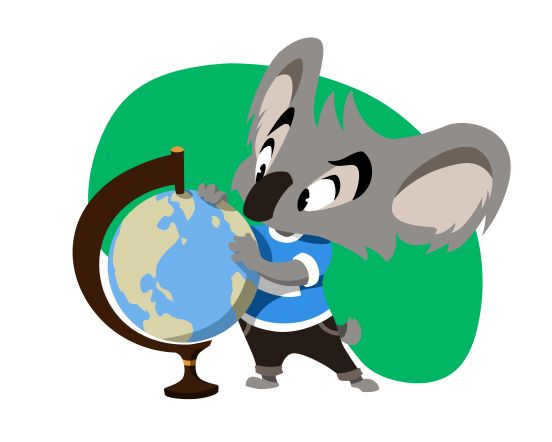
Our online course, called “Amazing Planet,” introduces children to the most significant locations in Russia and around the globe in an engaging manner, using games, stories, and riddles.
The cosmos encompasses everything that is known, including the realm where life thrives and the principles that govern its existence. This concept holds immense significance and should be taught to children from a young age. Although it may appear challenging, explaining the cosmos to children is not as daunting as it seems; one simply needs to employ the right approach.
The universe can be complex, even for adults who are unfamiliar with the terminology. However, there is ample information available to educate people of all races and ages. Therefore, by examining the smallest house, one can gain an instantaneous understanding of the entire cosmos.
How was the universe created for kids? The best way to explain it to the little ones at home!
When it comes to explaining how the universe was created for children, it really depends on each family’s beliefs. For those who are more inclined towards religion, the explanation revolves around the concept of God creating everything we know.
However, the question of how the universe was created for children is still a mystery that science has yet to fully answer. While the Big Bang theory is the most widely accepted and talked about explanation, the actual event remains unknown.
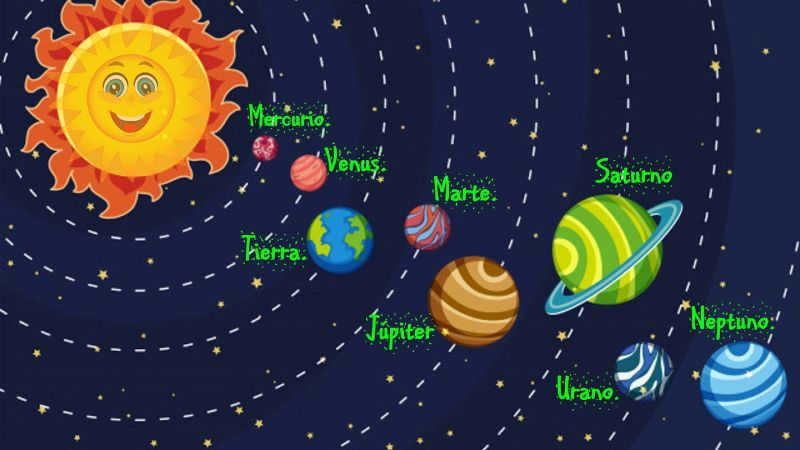
However, when it comes to early childhood education, it’s crucial to consider both perspectives. This doesn’t imply that one side is right or wrong; instead, it enhances your ability to think critically and stimulates your curiosity.
The religious perspective on the origin of the universe
The universe is believed to be God’s magnificent creation, representing an all-powerful being who is loving and compassionate towards humanity. It is said that God created everything that exists in the universe.
From the celestial bodies such as planets, to the most radiant and distant stars, God is even credited with forming the planet where humans reside, known as Earth.
As per the narrative, it required God 7 days to create his magnificent masterpiece. As a result, religion strongly argues that the entirety of existence is subordinate to God’s power and will.
The genesis of the cosmos according to scientific theories
The genesis of the cosmos according to scientific theories does not acknowledge any involvement of God in its creation. Conversely, it posits that everything we comprehend, undergo, and perceive originated from a colossal explosion.
Indeed, a massive detonation, known as the Big Bang, from which the universe commenced its meandering. It was from the very moment when it transitioned from nothingness to existence that the universe initiated its continuous expansion.
Imagine a balloon filled with water. When you exceed its limits, it will burst and release all its contents. The universe is like that water balloon, bursting at the beginning and giving birth to everything we see today.
The creation of the universe did not happen in 7 days, as religious beliefs suggest. On the contrary, once the expansion started, the process of creation has never stopped. Today, 14 billion years later, the cosmos is completely different from what it was in its early days.
What does the universe mean to children? A unique perspective on one of the most expansive concepts!
Explaining the universe to kids is not a difficult task. However, it’s important to avoid getting lost in its various interpretations. It’s also recommended to be patient and engage with the child to ensure their understanding.
In essence, the universe encompasses everything. It encompasses all aspects of existence, including what can be seen, touched, felt, discovered, and explored. It is also the home of our planet Earth, as well as the other planets in our solar system, the Moon, and the Sun.
Additionally, the universe is a vast expanse filled with brilliant stars that can be observed in the night sky. While not all of these objects are stars, they are recognized as part of the cosmos.
Galaxies are large clusters where stars are organized, playing a vital role in the universe. Other key players include time, space, light, and the multitude of elements found in reality.
On the flip side, the universe is teeming with enigmatic protagonists that continue to be explored. Among these, black holes are particularly intriguing, along with other significant anomalies.
When explaining the vastness of the universe to children, it is important to emphasize that its exact size remains a mystery. In fact, it would take 1 million years to travel from the sun to the nearest star. To truly comprehend its enormity, it would require an infinite number of lifetimes, if that were even possible.
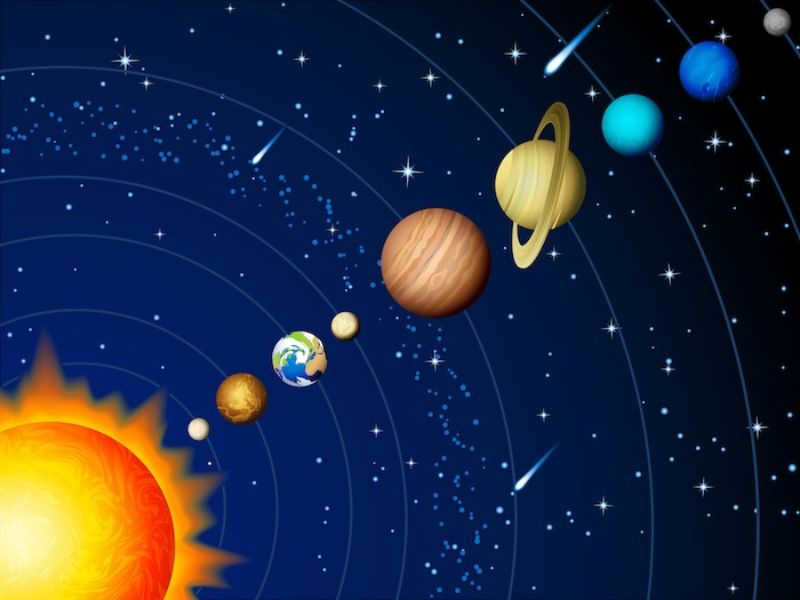
Introduce children to the cosmos and foster scientific knowledge in infants. Moreover, it enables them to connect with the true nature of their surroundings, irrespective of their beliefs.
Unveil the wonders of the cosmos to infants, which also enhances their scientific acumen. Consequently, this is associated with the ability to comprehend that existence is interconnected and nothing exists in isolation.
Early exposure to the knowledge of the universe is crucial for comprehending its workings. Consequently, one gains an understanding of the laws that govern it and the entities involved in its vast expansion.
The content of this article adheres to our principles of editorial integrity. To report an error, click here.
Full article path: postpost "Science" We provide a comprehensive explanation of the universe tailored specifically for children! Below, we have outlined the key details for your convenience.
When did the universe come into being? How did life originate? What species inhabited our planet? These inquiries have been pondered by humanity since time immemorial, as we have diligently sought out the answers.
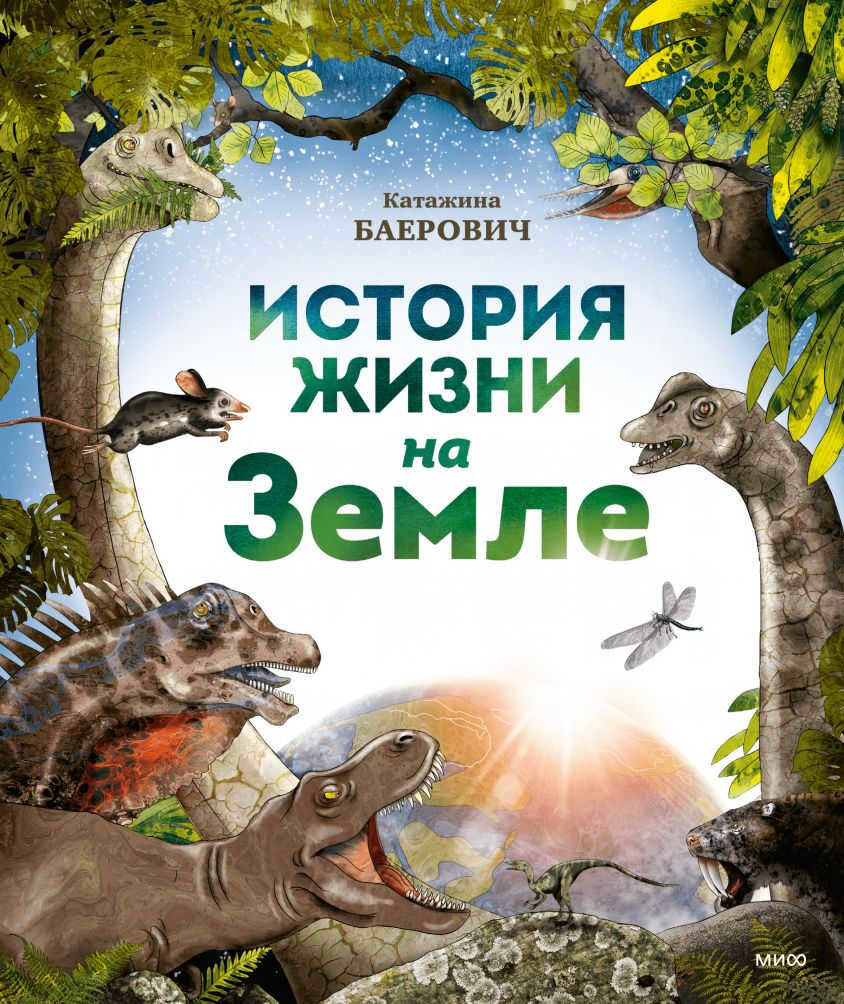
But what was the true sequence of events? The History of Life on Earth, an enthralling publication grounded in contemporary scientific evidence, recounts the narrative of pre-human existence: the genesis of the cosmos, the initial flora and fauna, and the catastrophic upheavals and transformations in the natural world that have been vital to our planet.
History of life on Earth
We extend an invitation for you to peruse a few excerpts from this captivating publication.
The turbulent start of our planet
What was the condition of our planet around four and a half billion years back? To be honest, it was completely unsuitable for supporting life. Earth had recently formed from cosmic dust and was still in its early stages. Our planet was brimming with energy, boiling, bubbling, shaking, and even erupting. It was constantly bombarded by meteorites and asteroids, which are small rocky celestial bodies that circled around the Sun. It was an utter chaos. This continued for an extensive period of time, but not indefinitely.
After 150 million years, the planet started to settle down: becoming calmer and cooler. It had a delicate outer layer. The Earth desired some rest, but there was a problem – the fragile shell was once again shattered by restless meteorites.
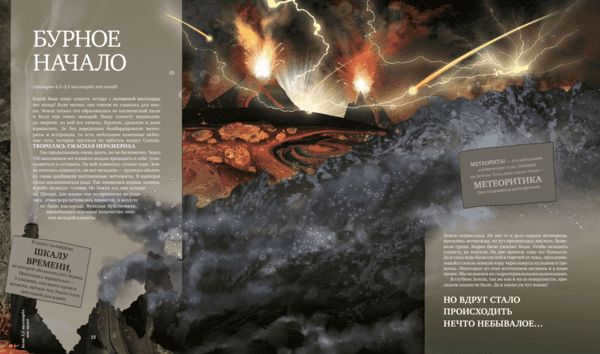
The image provided above and below is taken from The Story of Life on Earth.
The Earth experienced intense geological activity, with meteorites and asteroids colliding with it, and acid raining down from the clouds. Thunderstorms raged across the planet, creating a scorching hot environment. However, there was a lack of water to cool the Earth, and the oceans were bubbling with acidic and hot water due to volcanic activity. Some of these hydrothermal chimneys, which are still active today, allowed lava to seep through the Earth’s crust. Deep inside the Earth, as well as on its surface, there were no signs of life.
But then, something extraordinary occurred. The first living cell emerged, marking the birth of life.

Learn how to support your child’s learning. Take advantage of this free short course
Discovering The Blue Planet
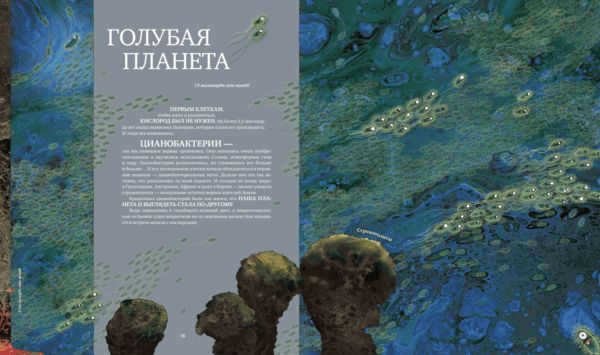
Approximately 3 billion years ago, the initial forms of life did not require oxygen in order to survive and evolve. However, around 3.5 billion years ago, bacteria emerged and began producing oxygen, leading to significant changes. These bacteria, known as cyanobacteria, were highly adaptable and learned to utilize sunlight, atmospheric gases, and water.
As cyanobacteria multiplied, they started to form large colonies known as cyanobacterial mats. The rapid growth of these mats allowed them to spread across the entire planet. Even today, remnants of these mats can be found in various locations around the world, including Greenland, Australia, Africa, and Europe.
Our planet underwent a transformation as a result of the proliferation of countless microscopic cyanobacteria. The waters took on a bluish-green hue, while the small pockets of land became tinged with red due to the oxidation of iron.
The Formation of Continents
During the period spanning from 1.3 billion to 635 million years ago, the Earth itself was also going through changes. Life emerged during this time, and the planet underwent significant transformations. Although we cannot be certain of the exact appearance of the Earth during this era (as photography did not yet exist), it is believed that a single massive continent known as Rodinia dominated the planet, surrounded by the vast ocean of Mirovia. Rodinia persisted for approximately 400-500 million years.
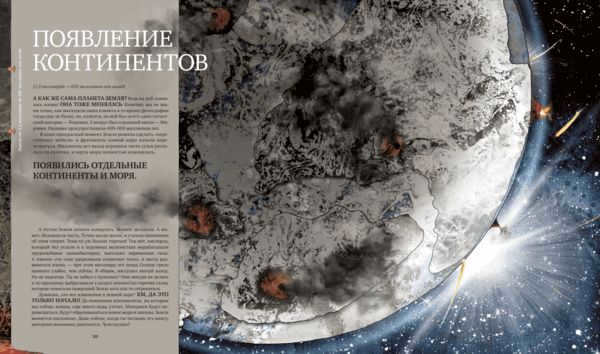
During a particular moment in time, the Earth made a decision to rearrange its furniture, resulting in the movement of fragments of the Earth’s crust. Many millions of years ago, a massive portion of land broke apart into smaller pieces, leading to a complete transformation of the world map. This process gave rise to separate continents and seas. Subsequently, the Earth entered a freezing period. It is uncertain whether this affected the entire planet or just a majority of it, as scientists continue to engage in lively debates on the subject. It has become a highly debated topic!
Thus, oxygen, which was tirelessly produced in large quantities by hard-working cyanobacteria, displaced greenhouse gases. These gases were responsible for trapping the heat from the sun, allowing life to flourish. It is worth noting that a billion years ago, the sun was significantly weaker than it is today, resulting in extremely cold temperatures. However, this cold spell was not permanent.
Once upon a time, in a time so long ago
Around 540 million years in the past, there emerged life forms on this planet… However, the perplexing question remains – were they animals or plants? These peculiar beings take on various curious forms: resembling worms, quilts, pillows, feathers, or cups. Sadly, their soft bodies, devoid of shells, have not always been well-preserved, leaving behind numerous unsolved mysteries. Whether all of these creatures perished or some underwent tremendous transformations remains unknown. There is still so much more to discover!
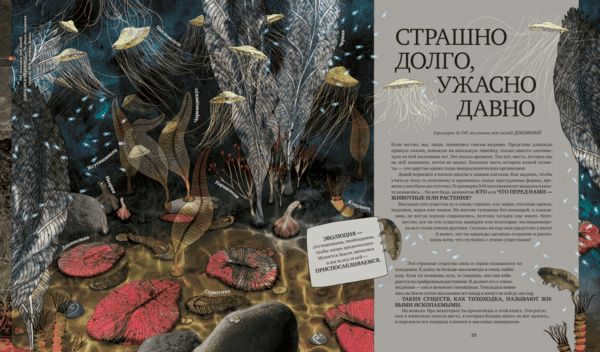
The creatures depicted in the image (gray, caterpillar-like organisms) are known as quietwalkers. They measure no more than one millimeter in length and have a strong affinity for water.
Upon close examination with a magnifying glass, one can observe them slowly climbing up coastal vegetation. Their gradual movements resemble those of a slow-walker. These organisms first appeared on Earth millions of years ago and continue to inhabit the planet to this day. They are classified as living fossils, a term that encompasses various other species as well. This book will delve into some of these extraordinary plants and animals, which have managed to thrive in environments where most others cannot survive, successfully weathering the challenges posed by climate fluctuations and mass extinctions.

